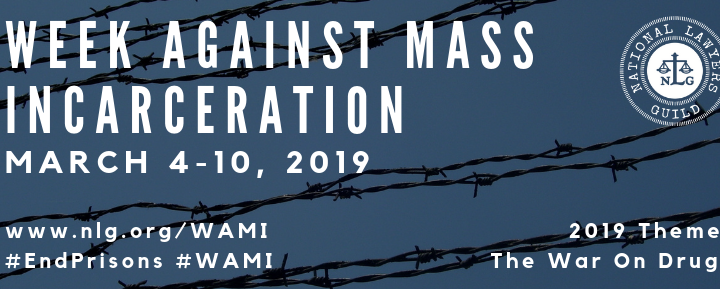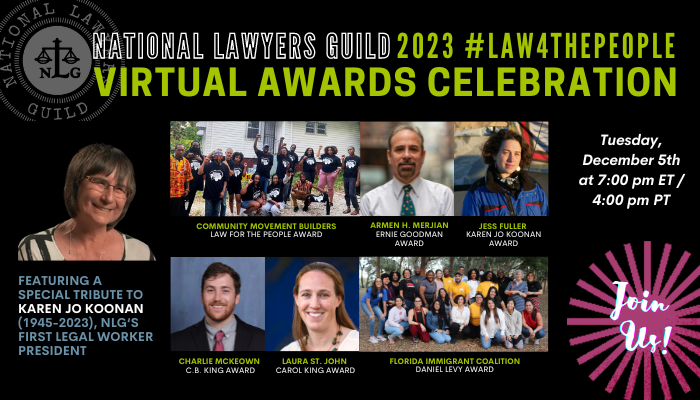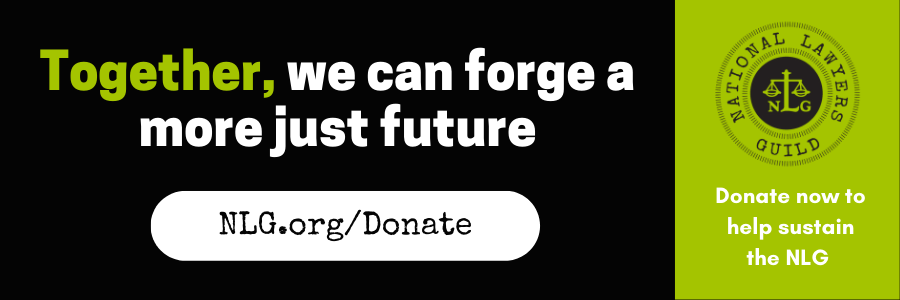We are publishing this piece as part of the NLG annual student Week Against Mass Incarceration. In 2019, we are highlighting the connections between the exponential increase of incarcerated people and the 40-year War on Drugs.
By Lisa Drapkin, NLG Director of Membership
The cultural narrative around drug use in the US is constantly shifting, but what doesn’t change is that there are always two completely different paradigms shaped by our longstanding history of racism and white supremacy. A few trends in public discourse in recent years include the legalization of marijuana, the usage of psychedelic drugs for mental health purposes, and the soaring rate of opioid addiction. If we look closely at the relationship of these trends to racial dynamics, we notice that within our white dominated society, white people remain the ones receiving the benefits that drugs can potentially bring while people of color, especially Black folks, are restricted from entering that same world.
Marijuana Legalization
The Guild has taken a strong position on marijuana legalization since 2013, when we published our report, High Crimes: Strategies to Further Marijuana Legalization Initiatives. There are currently 10 states where recreational marijuana is legal and those numbers will likely continue growing in this increasingly profitable industry. Like other industries, however, profits seem to remain within the upper class. As Business Insider reports, the “booming cannabis industry” is set to skyrocket to $75 billion, and venture capital firms are making deals fast. Though one of the reasons the people on the bottom who have suffered the most as targets of the “War on Drugs” are remaining there is because to succeed in this industry one needs to already have a huge bankroll to fund incredibly high licensing fees and taxes.
In The Root article titled Why Black People are Being Left Out of the Weed Boom, the writer interviews a street dealer in Washington, D.C. where weed is now legal, explaining why he wouldn’t become someone who sells weed legally. The dealer explained that there are so many restrictions and rules involved in getting a license. All the start-up fees came out to nearly $350,000, and other states had similar prices. It’s not surprising that in 2016 only about 1% of the nation’s more than 3,500 marijuana dispensaries were owned by African Americans. As a Colorado “cannabis lawyer” states, “It’s disappointing that the very people impacted the most by this part of the war on drugs are not able to participate in what is now the legal regulated world. And it’s not just because of criminal backgrounds, but because these businesses in some states have high barriers to entry: lots of money, huge infrastructure costs and political connections.” On top of that, small business loans are not available to people who need them in this industry because banks are federally insured and marijuana remains illegal on a federal level.
Another major barrier to African Americans gaining entry into this wealth is former criminal convictions for possession. An expansive 2016 BuzzFeed News piece, titled America’s Whites-Only Weed Boom, explores the issue of how laws prevent thousands of qualified Black people from entering the industry. A person often cannot get hired at a dispensary if they have any former drug conviction felonies. One example was that of Unique Henderson, a young black man who had hoped to get a job at a medical marijuana dispensary when they opened in Colorado in 2009. He was more than qualified for the job, but because he got caught twice with a joint’s worth of pot when he was a teenager, he was barred. Legal barriers enforced through a racist lens also continuously rise for black people who do manage to break into the industry. It becomes quite complicated, even beyond just having convictions. As the author states, “many of the black people ‘with a business mind’ who have tried to get involved in marijuana have already encountered the same racism and disproportionate policing as before pot became legal.”
When the question is raised as to who has historically been punished for using marijuana, it is clear the answer is black people. To give some examples, a report by the Drug Policy Alliance shows that in Georgia, where 1 in 33 black men are incarcerated, in 2017 nearly 73% of all those in prison for marijuana charges were black despite making up only 32% of the total population. An editorial in the New York Times titled Boehner Benefits from Weed, While Blacks are in Prison for Using It, portrays the hypocrisy in our criminal justice system by showing the contrast between a prisoner in Louisiana, and John Boehner, the Ohio Republican who is former speaker of the House of Representatives: “A decade ago, an undercover police officer approached Mr. Winslow, a homeless black man, and asked for help buying marijuana. Mr. Winslow desperately needed the money, so he helped the officer buy two dime bags for a $5 profit. For that, he is serving life without parole for distribution of marijuana in the infamous Angola prison.” That same year, Boehner joined the Board of a marijuana cultivation and distribution company, after several previous votes against any form of legalization. He therefore profited from something he himself helped make illegal, forcing people like Mr. Winslow’s life to be destroyed.
The ACLU’s War on Marijuana in Black and White states that “marijuana arrests now account for over half of all drug arrests in the United States. Of the 8.2 million marijuana arrests between 2001 and 2010, 88% were for simply having marijuana. Nationwide, the arrest data revealed one consistent trend: significant racial bias. Despite roughly equal usage rates, Blacks are 3.73 times more likely than whites to be arrested for marijuana.” In some states (DC, IA, MN, IL), that arrest rate was more than 8% likely. In an Intercept article titled Despite Liberalizing Marijuana Laws, the War on Drugs Still Target People of Color, Sean King points out that even in states like Colorado where weed is legal, arrests are still showing a racial disparity. He writes, “In Colorado, which legalized recreational marijuana, arrests of white people have plummeted, but arrests of African-Americans and Latinos have actually skyrocketed as much as 50 percent.” The story seems to be the same in D.C., another place that has recently legalized. A Washington Post editorial remarks how there is a lot of fine print that protects the rights of white people to smoke more than those of black people whose plights helped get legalization passed. The author writes, “Under the new laws, you could smoke, but only in your home. Not outdoors. For those living in apartments and public housing, where smoking is prohibited, nothing had really changed. The same draconian laws that underpinned the “war on drugs” were still in effect for them.” Within one year since legalization, arrests for smoking marijuana in public jumped from 142 to 400; arrests for selling have also tripled.
Psychedelic Therapy
Psychedelic therapy is another drug-related arena that largely excludes people of color. Business Insider reports that there has been a recent resurgence of interest in the potential that psychedelic drugs have in helping conditions like depression and anxiety, and investors are contributing millions to this research. Though unsurprisingly, not everyone is benefitting from the potential gains. In a recent article titled Blacks Are Being Left Out of Psychedelic Research, the author argues that a person’s race or income level can prevent their access to treatments that involve these drugs. In a large sample study of who has been included thus far in experimental psychedelic psychotherapy treatment, it was found that 82% of the patients were white even though the research is open to people of all races. One reason mentioned is the severe lack of therapists in this field who are not white. Monnica Williams, a clinical psychologist professor who is spearheading the first MDMA study on treating racial and sexual traumas in minority populations, is one of the few people trying to address this problem: “The life experiences for people of color are often so different than those of white people. By having another person of color, they’re much more likely to empathize appropriately.” The article also mentions that training therapists of color would help ease the deeply rooted mistrust that black people have of the medical community, because of the fact that the U.S. has a horrific history of using minority groups in unfair, non-consensual medical experimentation.
When it comes to recreational use, a recent segment in Psymposia.com (which showcases perspectives on how emerging psychedelic science and drug policy reform can work to transform society) titled Why the Psychedelic Community is So White, discusses the world of psychedelics from the point of view of a black woman who is a part of it. The author writes, “The ability to talk about drug use, especially psychedelic drug use, is a huge privilege in the United States. Black people are murdered by cops on a regular basis while walking down the street and minding their own business, just for being black; so imagine the risk for black people that comes with talking openly about psychedelics. Imagine what would happen if large numbers of Black folks gathered to talk about healing our trauma with psychedelics. Such a convening would probably be shut down quickly by the state, much like they did with the MOVE bombings in Philadelphia, the Black Panther Party, Black Wall Street and more recently, the Ferguson uprising and Standing Rock. We, as black people, risk our lives every day just by being black; so it should come as no surprise that we hesitate when it comes to openly speaking about drug use.” She argues it would benefit the psychedelic movement to fight against oppressive institutions in order for more black people who do use psychedelics to feel like the movement is actually noticing the systemic oppression they face. Another piece in the same series mentions annual events where the use of psychedelic drugs is celebrated, such as the Rainbow Gathering and Burning Man, and reflects on how impactful it would be if the thousands of attendees of these events made it a point to actively work toward radical inclusivity and tangible ways to support oppressed communities who don’t have the same privilege.
Opioids
Lastly, stories of deaths from opioid overdoses have been widespread in the media lately, as more and more people have become addicted to pain medication. Of course it is clear to see the contrasting responses of the current opioid “crisis” versus the crack “epidemic” of the 1980s. As the writer of What the Crack Epidemic and Opioid Crisis Tell Us About Race in America explains, “An epidemic is a widespread occurrence of an infectious disease within a community. A crisis is a time of intense difficulty, trouble, or danger. The feelings conjured by the word epidemic tells you to run. You must get away. Run as fast and far as possible. A crisis is different. A crisis evokes empathy. A crisis motivates you to help.” The 1980s were a time that fueled mass incarceration and destroyed black communities who were vilified as horrible savages that needed to be locked away from the rest of society. (See the NLG’s Resolution calling for an End to the War on Drugs). Now with the opioid crisis affecting mainly white communities, its victims are being treated more similarly to children who deserve the utmost compassion for a disease they can’t control. Less discussed are the many studies that reflect how racial bias in the medical community affects the overall amount in which opioids are actually prescribed to black people and why it is seen as an issue affecting mainly whites.
An article in The Guardian analyzed the results of a 2016 study about the racial-ethnic disparities in opioid prescriptions during emergency room visits (for conditions which would normally be associated with narcotic abuse). The study found that black patients were half as likely to be prescribed opioids as their white counterparts with the same symptoms. The article also mentioned a previous study about how disparities in pain management may be connected to bias from medical providers who believe falsehoods such as black people aging slower than white people, and that black people’s blood coagulates more rapidly. There is also a history of assuming black people are more likely to be addicts. According to the Association of American Medical Colleges, only a 4% of physicians are black, which seems like a pivotal piece of why medical bias is so prevalent. Citing a more recent study, an article in US News titled How Racial Bias Has Shaped the Opioid Epidemic exemplifies the stark racial and class divides in drug addiction and overdose deaths in California. In the poorest and whitest areas in CA, 44% of adults received at least one opioid prescription per year on average, compared with 16% percent of adults in the richest, most racially diverse areas. In the state’s lowest-income, most racially diverse areas, only 20% percent of adults were prescribed at least one opioid prescription. Prescriptions for other narcotics like stimulants and benzodiazepines were also more prevalent in white areas. The doctor interviewed in this article writes, “These disparities may have ironically shielded communities of color from the brunt of the opioid epidemic, but they also represent disparities in the form of lack of adequate access for the treatment of pain and psychiatric conditions.”
Even when black people were prescribed opiates, they were monitored more closely than their white counterparts. A Yale study conducted from 2000-2010 found that while the Centers for Disease Control recommends that patients on opioid prescriptions be tested for illicit drug use, very few actually were. However when they were tested, black opioid patients were twice as likely to be tested than their white counterparts. On top of that, black patients were more likely to have their pain medication discontinued if any other drug was found in their system. Specifically, black patients who tested positive for marijuana had their pain prescriptions discontinued at two times the rate of white patients who also tested positive. The Root article amplifying this study says, “The study supports the widespread belief that white drug users are treated with more care and sympathy than black people who use drugs.”
Peg O’Connor, a philosophy professor whose expertise lies in the convergence of western philosophy and addiction focuses on the statistical fact that white people are dying from opioid overdoses at a much higher rate than black people, and explores the reasons why this is so. She brings up insurance as a factor, and how even having health insurance doesn’t necessarily mean people will use it when there are high co-pays or deductibles attached and few providers within their area (not to mention having no paid sick days off of work). She says this equates overall to fewer black people entering or remaining in the healthcare system, and the lack of access keeps them from being prescribed pain medications. Those who do have access tend to encounter racism that can affect the care they receive :“A lack of empathy to the pain of black people is an important factor in the disparity of pain management. Quite simply, white people believe black people do not feel as much pain as white people.” This disparity between what white and black people get prescribed can take the form of what actually gets prescribed in regard to whether or not it’s a narcotic and how strong the dosage will be. She points out that the medical community shares the stereotype that black people are are there to deceive the system as a drug dealer or user. A Think Progress piece about racial bias ties this trend to remnants of America’s turbulent racial history. As a medical professor explains, “During slavery, it was widely believed that African Americans didn’t need medication because they had a high tolerance for pain. It’s a striking parallel that today blacks tend to receive poorer quality care and are under-treated for pain, although today this occurs largely outside of conscious awareness”.
Looking Towards the Future
So what can be looked at as hopeful when thinking about the disturbing nature of these trends? When it comes to marijuana reform, politicians like Alexandria Ocasio-Cortez are emphasizing that we can’t undo but can redress past injustices. When it comes to individual states that have legalized marijuana, California seems to be leading the way in recognizing who legalization needs to benefit. The city of Oakland is designating half of the its marijuana licenses for low-income residents, those convicted of a cannabis crime or those living in a specified neighborhood with high drug enforcement. In September 2018, CA Governor Jerry Brown signed a bill that allows local jurisdictions to apply for grants to help people most affected by the drug war to enter the industry, and has pledged to set aside $10 million to provide technical assistance and pay for permits or license fees. On top of helping out financially, San Francisco District Attorney George Gascón announced in January 2018 that the city would automatically apply California’s marijuana legalization laws retroactively (back until 1975), and so thousands of mainly black people convicted of misdemeanor possession will have their criminal records completely expunged. The rest of the state matched this streamlined process when the Governor signed a bill in October 2018 allowing around 200,000 CA residents to have their records cleared as well. Other states seem to be following suit, particularly in Colorado, where in December 2018 the mayor of Denver announced that they are developing a process to speed up record sealing for certain marijuana-related misdemeanors that occurred before legalization took effect.
The medical profession is far from confronting racial bias. The author of a recent New York Times editorial writes, “the Agency for Healthcare Research and Quality issued its 15th yearly report on health care quality and disparities, as called for by the medical institute in 2002. It found that while some disparities had gotten better, many remained. The most recent data available showed that 40 percent of the quality measures were still worse for blacks than whites.” Think Progress posted an article with some possible solutions, speaking with physicians and students focused on this issue. Researchers put together a training program called the Every Day Bias Workshop, which aims to teach medical professionals how their assumptions affect the decisions they make about communication, innovation, and organizational culture, with the goal of also utilizing these training methods in medical schools and teaching hospitals. The makers of the training hope it will also help in getting schools to accept more black students. The article also features #WhiteCoats4BlackLives, a national, medical student-run organization devoted to safeguarding the lives of patients through the elimination of conscious and unconscious bias in the delivery of healthcare caused by systemic racism. Their list of chapters is impressive, and they keep a racial justice scorecard that evaluates an academic center’s curriculum and climate, student and faculty diversity, policing, racial integration of clinical care sites, treatment of workers, and research protocols. Students like these will hopefully grow in presence in the medical profession over time and help to change the current paradigm.
On a broader level though, it seems clear that whatever drug we’re talking about, white people are generally the ones making profit and accessing it freely, while black people of color are being perpetually kept at the bottom of the ladder, experiencing trauma from the war on drugs which continues to affect them, and unable even to legally seek out medications for mental or physical pain that white people have readily available to them. Black people are not only experiencing the most trauma from incarceration but also have the least amount of care to heal. Even just anecdotally, those who get released on parole are drug tested and can be thrown back in prison for using the same substance that people in other states are utilizing to not only get rich but also for mental treatment.
These marked discrepancies surrounding our drug culture are one of the many reasons why the NLG supports prison abolition. We demonstrate our support in ways that focus on communicating with those inside, such as the Bay Area Chapter’s Prison Advocacy Network, working with those facing the worst conditions while still fighting for their and others’ rights, the Prison Legal Advocacy Network of the NLG DE-NJ Chapter documenting abuse, and our Beyond Bars pieces in Guild Notes. With the prison industry strong and intact, the cycle will continue: the state perpetuates the myth that black people experiencing addiction are disposable and unworthy of compassion, and the existence of prisons makes this a reality. As long as there are people who are continually seen even implicitly as second class citizens, deemed more punishable than their white counterparts, the presence of the prison industrial complex in the U.S. makes an equal playing field quite impossible for not only this but for all aspects of our society.



